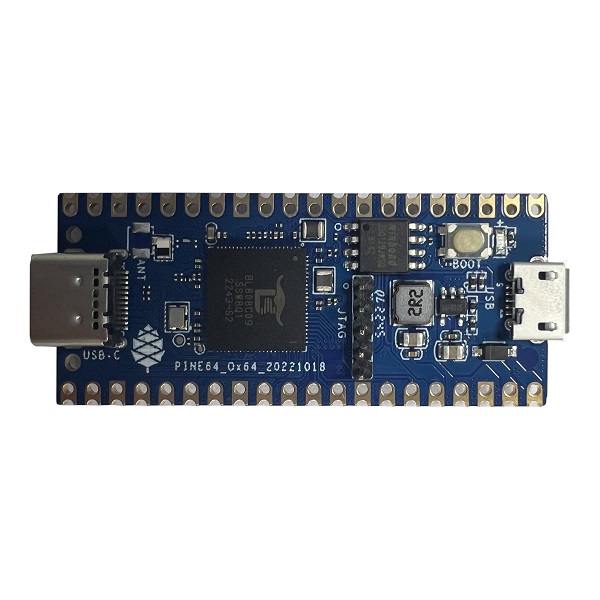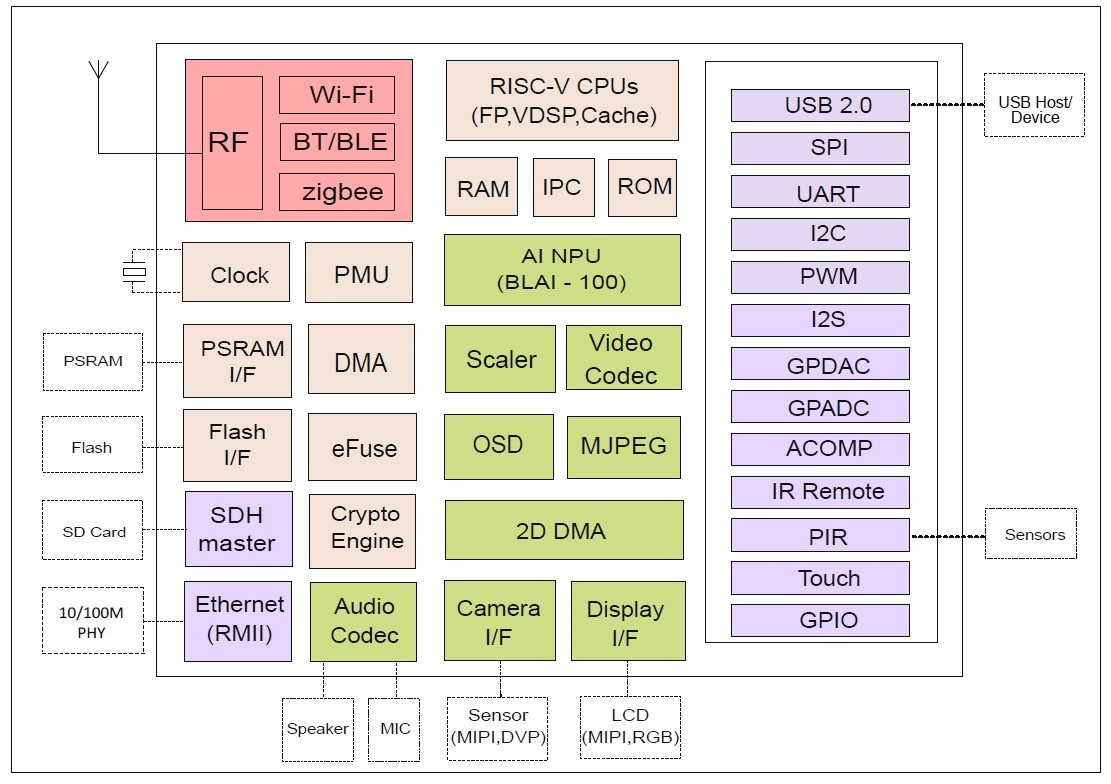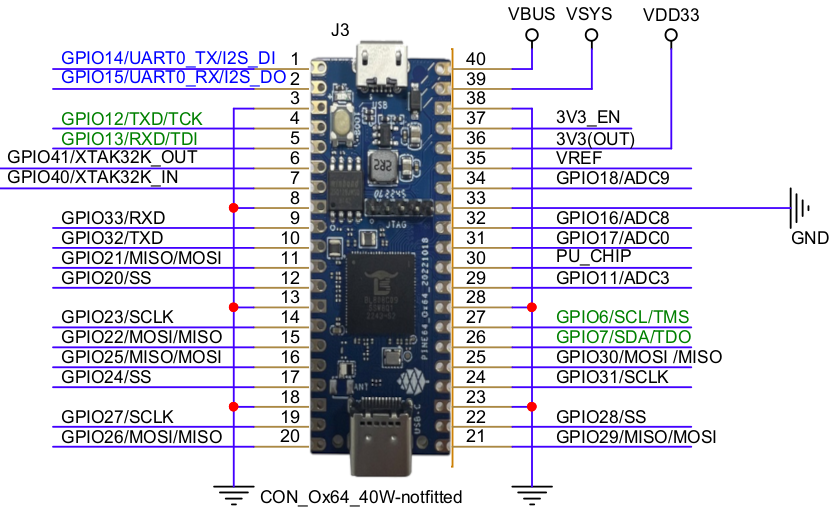Difference between revisions of "Ox64"
Jump to navigation
Jump to search
(Building the Xuantie GNU Toolchain on macOS and Apple Silicon) |
|||
| Line 124: | Line 124: | ||
* If you see "Shake hand fail" and an empty ack, and your device is in bootloader mode, then it is likely an incompatible UART. | * If you see "Shake hand fail" and an empty ack, and your device is in bootloader mode, then it is likely an incompatible UART. | ||
* The below devices have been tested and verified as working | * The below devices have been tested and verified as working | ||
** Raspberry Pi Pico - running a | ** Raspberry Pi Pico - running a [hhttps://github.com/sanjay900/ox64-uart/releases/tag/v1.1 uart firmware] | ||
** | ** ESP32 with CP210x - bridge the EN pin to ground to disable the ESP32 itself, and then connect the TX on the esp32 to 14 on the Ox64 and RX to pin 15. Note that only baud rate 115200 works, and this doesn't seem to work for everyone) | ||
** STM32F401 BlackPill - running the [https://github.com/blackmagic-debug/blackmagic/tree/main/src/platforms/blackpillv2 Black Magic Debug] firmware | ** STM32F401 BlackPill - running the [https://github.com/blackmagic-debug/blackmagic/tree/main/src/platforms/blackpillv2 Black Magic Debug] firmware | ||
** Some UART adapters based on the FT232H (note that the FT232RL does not work, and neither does the Pine 64 JTAG) | ** Some UART adapters based on the FT232H (note that the FT232RL does not work, and neither does the Pine 64 JTAG) | ||
Revision as of 05:58, 30 December 2022
The Ox64 is a RISC-V based Single Board Computer powered by Bouffalo Lab BL808 C906 64-Bit RISC-V CPU, 32-Bit CPU, embedded 64MB PSRAM memory and build-on 3 radio RF (Wifi, BT, Zigbee). It provides breadboard friendly form factor, MicroSD Card slot, USB 2.0, and many other peripheral interfaces for makers to integrate with sensors and other devices.
Software Releases
Quick Links to the Source of OS Images Build
OS images are still in alpha build which are only fit for board bring up and testing purposes.
- Linux for BL808
- Installation Instructions for Linux on BL808 (Chinese)
- Installation Instructions for Linux on BL808 (English Auto-Translation)
- Toolchain:
- elf_newlib_toolchain/bin/riscv64-unknown-elf-gcc (Xuantie-900 elf newlib gcc Toolchain V2.2.5 B-20220323) 10.2.0
- linux_toolchain/bin/riscv64-unknown-linux-gnu-gcc (Xuantie-900 linux-5.10.4 glibc gcc Toolchain V2.2.4 B-20211227) 10.2.0
- cmake version 3.19.3
Software Development Kits
- BL808 MCU SDK
- BLDevCube Flashing Tool for Windows, macOS and Ubuntu x64
- Ox64 UART Flashing Guide (Notes)
- BL808 Demo Firmware: bl808_demo_event.bin (Notes)
- BL808 UART Log Firmware: whole_flash_data.bin (Notes)
- BL808 DVK Quick Start
- OpenSBI for BL808
- Rust Peripheral Access Crate (PAC) for BL808
- System View Description (SVD) for BL808
SoC and Memory Specification
- Based on Bouffalo Lab BL808
CPU Architecture
- Supports RISC-V RV64IMAFCV instruction architecture
- Five-stage single-issue sequentially executed pipeline
- Level-1 instruction and data cache of Harvard architecture, with a size of 32 KB and a cache line of 64B
- Sv39 memory management unit, realizing the conversion of virtual and real addresses and memory management
- jTLB that supports 128 entries
- Supports AXI 4.0 128-bit master interface
- Supports core local interrupt (CLINT) and platform-level interrupt controller (PLIC)
- With 80 external interrupt sources, 3 bits for configuring interrupt priority
- Supports BHT (8K) and BTB
- Compatible with RISC-V PMP, 8 configurable areas
- Supports hardware performance monitor (HPM) units
- T_head E907 320MHz 32-bit RISC-V CPU
- Supports RISC-V RV32IMAFCP instruction set
- Supports RISC-V 32-bit/16-bit mixed instruction set
- Supports RISC-V machine mode and user mode
- Thirty-two 32-bit integer general purpose registers (GPR) and thirty-two 32-bit/64-bit floating-point GPRs
- Integer (5-stage)/floating-point (7-stage), single-issue, sequentially executed pipeline
- Supports AXI 4.0 main device interface and AHB 5.0 peripheral interface
- 32K instruction cache, two-way set associative structure
- 16K data cache, two-way set associative structure
System Memory
- Embedded 64MB PSRAM
Board Features
Network
- 2.4GHz 1T1R WiFi 802.11 b/g/n
- Bluetooth 5.2
- Zigbee
- 10/100Mbps Ethernet (optional, on expansion board)
Storage
- on-board 16Mb (2MB) or 128Mb (16MB) XSPI NOR flash memory
- microSD - supports SDHC and SDXC
Expansion Ports
- USB 2.0 OTG port
- 26 GPIO Pins, including SPI, I2C and UART functionality. Possible I2S and GMII expansion
- Dual lane MiPi CSI port, located at USB-C port, for camera module
Audio
- mic (optional, on camera module)
- speaker (optional, on camera module)
Board Information, Schematics and Certifications
- Baseboard Dimensions: 51mm x 21mm x 19mm x 3.5mm (Breadboard friendly)
- Input Power: 5V 0.5A microSD or USB-C port
- Schematic:
Production version schematic:
- Pinout:
Prototype (dispatched to developers) schematic:
- Certifications:
- Disclaimer: Please note that PINE64 SBC is not a "final" product and in general certification is not necessary.
- Not yet available
Datasheets for Components and Peripherals
- Bouffalo BL808 SoC information:
- SPI NOR Flash information:
- Power Regulator information:
- MicroSD socket information:
Compatible UARTs when in bootloader mode
- When the Ox64 is in bootloader mode, some UARTs are unable to communicate with it. When this is the case, utilities such as BLDevCube are unable to actually program the device.
- If you see "Shake hand fail" and an empty ack, and your device is in bootloader mode, then it is likely an incompatible UART.
- The below devices have been tested and verified as working
- Raspberry Pi Pico - running a [hhttps://github.com/sanjay900/ox64-uart/releases/tag/v1.1 uart firmware]
- ESP32 with CP210x - bridge the EN pin to ground to disable the ESP32 itself, and then connect the TX on the esp32 to 14 on the Ox64 and RX to pin 15. Note that only baud rate 115200 works, and this doesn't seem to work for everyone)
- STM32F401 BlackPill - running the Black Magic Debug firmware
- Some UART adapters based on the FT232H (note that the FT232RL does not work, and neither does the Pine 64 JTAG)
- Some CH340G based adapters work and some don't.
GitHub/Gitlab
- Official Bouffalo BL-808 site
- Community made Arduino Core specifically for the Bouffalo Labs BL808 RISC-V MCU
Articles and Blogs
- First Batch of Ox64 won't appear as USB Serial Port
- First Batch of Ox64 tested OK with CH340C/G
- First thoughts on the (a)symmetry of Bouffalo Labs BL808 as in Pine64’s Ox64
- The $8 linux computer (with picoprobe-rp2040 programming instructions)
- Building the Xuantie GNU Toolchain for Ox64 on macOS and Apple Silicon




